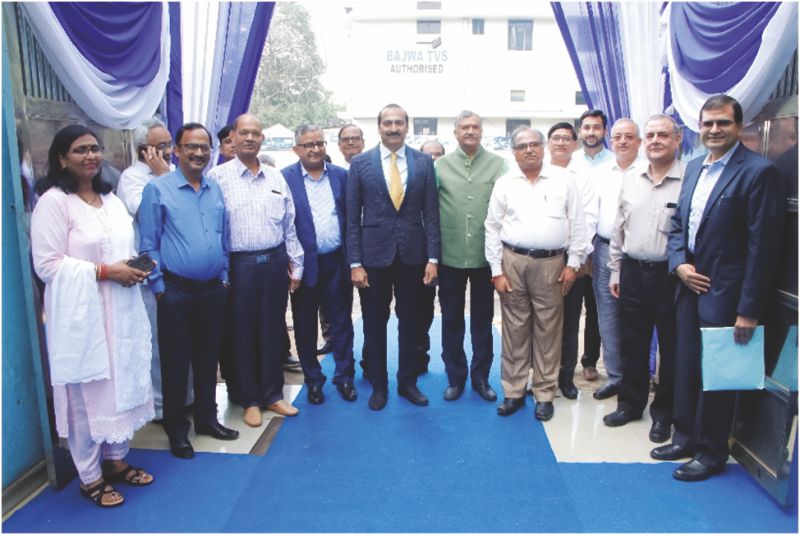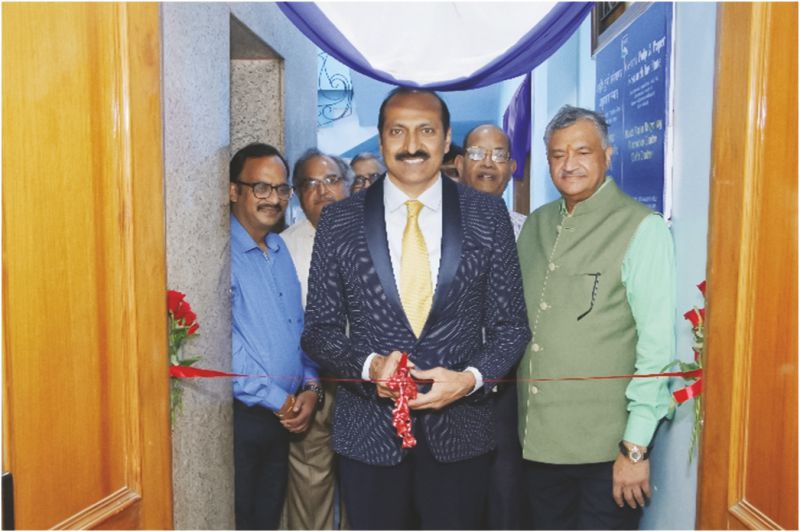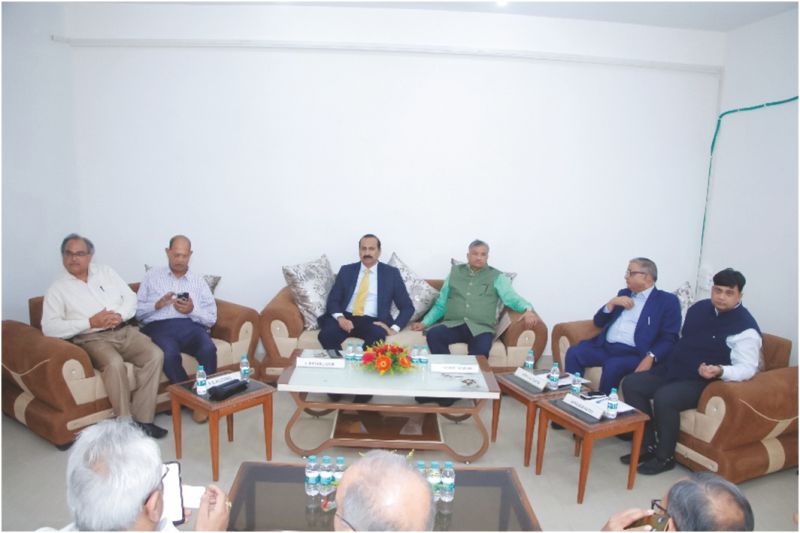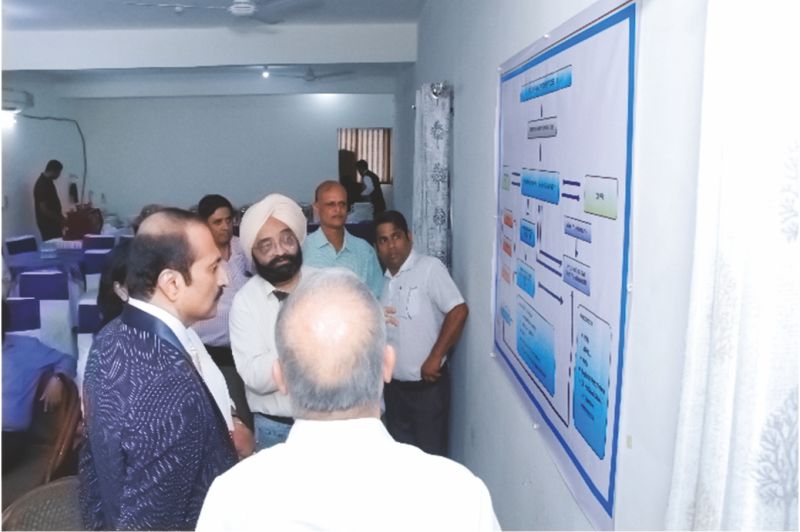The WPRPC Delhi Centre was inaugurated on October 12 at Patparganj Industrial Area by CPPRI. Mr. T. Balakumar, CMD, Subam Papers Pvt. Ltd. and Chairman of DCPPAI was the chief guest at the inaugural ceremony.

Central Pulp and Paper Research Institute (CPPRI), Saharanpur has been awarded a project on setting up of Waste Paper Recycle Promotion Centre (WPRPC) in New Delhi and Chennai. The WPRPC Delhi Centre was inaugurated on October 12, 2022, at Patparganj Industrial Area, New Delhi. This is the extension centre of Central Pulp and Paper Research Institute, Saharanpur, which will cater to the need of the pulp & paper industry including recycled paper collection and promotion activities. The project has been funded by the Department for Promotion of Industry and Internal Trade (DPIIT), Ministry of Commerce and Industry, under project-based support to CPPRI.
The event was inaugurated by the Chief Guest Mr. T. Balakumar, CMD, Subam Papers Pvt. Ltd. and Chairman of Development Council for Pulp, Paper & Allied Industries (DCPPAI). Reportedly, Mr. Pramod Agarwal, CMD, Rama Paper Mills Ltd. and President, IARPMA, and Dr. Tanweer Alam, Director, Indian Institute of Packaging (IIP), were the guests of honour.
Watch: IVAX Paper Chemicals Interview
Waste Paper as Resource
In his speech, Mr. Balakumar extended his best wishes to CPPRI & DCPPAI for the steps taken to enhance the usefulness of waste paper and said, “Union Road Transport and Highways Minister, Shri Nitin Gadkari says, the conversion of knowledge into wealth & waste into wealth is the future. Nothing is Waste. In fact, waste is a resource in the wrong place. Thus, the word ‘Waste Paper’ is superfluous as it is not useless but a valuable resource. As such the more appropriate word will be ‘Recovered Paper’.”
He added that the paper is bio-degradable, compostable and recycled easily; therefore the utilisation of the recovered paper helps in resource conservation, energy conservation and environmental sustainability. “The systematic and scientific knowledge about the collection, sorting, grading and recyclability will certainly help our paper industry in meeting raw material shortage as well as achieving the future projected paper demand of our country. It is indeed a step forward in making the nation an Atmanirbhar Bharat, a policy initiative of the Hon’ble Prime Minister Shri Modi Ji,” he said.
Sharing the statistics, he added, “The domestic paper industry produced 24 million tons of paper in the financial year 2020-2021with 4.32 million tons of paper contributing 18 percent of total production uses wood chiefly from the social forestry. Agricultural residues like bagasse and wheat straw are used to produce 2.4 million tonne, contributing 10 percent of the total production. 17.28 million tons contributing 72 percent share of the total production was produced from recovered paper and or waste paper. The recovered paper presently constitutes the major raw material base for the domestic paper industry. Taking into consideration an average of 80-85 percent yield in the papermaking process; the consumption of recovered paper amounts to 20 million tons per annum.
As per the estimates, the present recovery rate in India for waste paper is of the order of more than 50 percent. The recovery rate is fast catching up but is much below as compared to the developed nations like Japan-81 percent, Europe-71.4 percent and the USA-68 percent and is at par with new emerging paper destination South Africa that is at 60 percent. According to industry estimates, the current recovered fiber collection system gives 12 million tons back to the paper mills. The shortfall of 8 million tons is being met by imports.”


Domestic Collection of Waste Paper: Challenges in the Frontier
Balakumar pointed out that the collection and segregation of waste paper in India are largely unorganised. The supplies of waste paper collected by thousands of waste pickers also include contaminated waste. The Home-to-Home value chain comprises direct collectors from various source points which then sell to the small vendors – where primary sorting of the waste into different categories takes place–and then goes to zonal segregation centres owned by wholesalers, where the waste material gets baled and dispatched to the paper mills. The contractor mechanism is also in place in India, which collects the paper waste from the converters and printers and had it segregated and resells to the paper mills.
“The concept of segregation of post-consumer waste is still a challenge. Some corporate houses are trying to address this crucial issue of post-consumer waste management, to ensure systematic collection, segregation and recycling of waste paper. There is a need for more such programs for improving waste paper collection, segregation and utilisation. In this perspective, setting up of this WPRPC centre is the right step,” he added.
“Recently, the Confederation of European Paper Industries (CEPI) has unveiled, the updated version of its European harmonised recyclability test method, developed in collaboration with stakeholders in the entire paper value chain, including specialised testing laboratories. The goal of this exercise is to make all paper packaging recyclable by 2025 and reach a recycling rate of 90 percent by 2030. The updated CEPI harmonised recyclability test method offers a solid basis for this work and allows paper products across Europe to be tested for their recyclability in identical conditions.”
“According to 2019 statistics available, the waste paper imports in India have jumped 3.5 times of 2011 level. The imports of waste paper in FY 2011 were to the tune of 28.31 billion rupees and reached 91.86 billion rupees in FY 2019. According to industry estimates, this has easily crossed the 110 billion rupees-mark, taking into account the rupee devaluation and increase in recovered fiber demand by the industry. It goes to show the dependence of the domestic paper industry on imported waste paper. As a result, the waste paper-based mills often face the dilemma in deciding on selling price due to the high volatility of the imported waste paper cost. It is also proposed RCF-based integrated mother pulp mills may be promoted from various regions of the country which can provide high-quality RCF-based pulp to the paper mills in the country. This will help in reducing the production cost, energy cost and ETP operation cost”, said Mr. Balakumar, adding “I am hopeful, that the WPRPC centre will also be helpful in providing authentic information and data to various stakeholders, specifically on waste price, supply and demand, benchmarks on various aspects related to raw material availability, paper production, and quality along with different geographical areas, SWOT analysis of this sector for further policy/guideline formulation, development of transaction-based recycled fiber price benchmark to help the industry in reducing the volatility and uncertainty in waste paper procurement prices, tracking and understanding market movements over time to correlate price changes and segmentation of apparent contract v/s spot to understand market dynamics and get insight into where the market is headed.”

WPRPC to Enhance Knowledge Pool of the Sector
“The data and knowledge base generated by WPRPC will help the industry to make fact-based decisions and protect the interest of the sector. The more confidence decision-makers have in the data they use, the more confidence they can have in their decisions. And when decision-makers have more confidence in their decisions, they can take aggressive action, translating to improved performance and profitable growth. The success of this promotion centre shall be depended on the participation of all stakeholders in the value chain including paper traders, waste paper suppliers, paper mills and paper users. Proper strategies and key interventions are required for enhancing waste collection in the country. CPPRI with the collective support and effort by all the stakeholders can make a positive contribution towards increasing the waste paper collection, thus contributing to the government initiative for Atmanirbhar Bharat, in the context of making indigenous fibrous raw material available to the domestic paper manufacturers and saving valuable foreign exchange. WPRPC in making this initiative a success needs to launch a high-impact awareness campaign to stimulate behaviour change in the public. It should also plan to increase awareness on waste paper recycling amongst school and school children.”
Also Read: IPPTA, CPPRI Organise Workshop on Pulping, Bleaching & Recovery in Paper Mills
Talking about the recent ban on single-use plastic (SUP) and the importance of paper, he expressed that WPRPC and FPTA should now take up the initiative for observing paper recycling day to increase awareness about the increased collection and utilisation of waste paper.
The inaugural ceremony was attended by Dr. M.K. Gupta, Director, Central Pulp and Paper Research Institute and the leaders of the paper fraternity of India including Mr. Satpal Gupta, MD, Narsingh Dass & Company Pvt. Ltd., Mr. R.C. Rastogi, MD, Khatema Fibres Ltd., and Dr. Madhab Chakraborty, Joint Director, Institute of Packaging (IIP), Dr. B.P. Thapliyal, Secretary General, IARPMA, Mr. Rohit Pandit, Secretary General IPMA, and Mr. Vijay Kumar, Secretary General, INMA. Various senior scientists of CPPRI including Dr. Kawaljeet Singh, Dr. Nitin Endlay, Dr. Sanjay Tyagi, and Mr. Alok Goel also attended the inaugural ceremony. The vote of thanks was given by Dr. Priti Shivhare Lal, scientist of CPPRI and the in-charge of WPRPC Delhi Centre.



